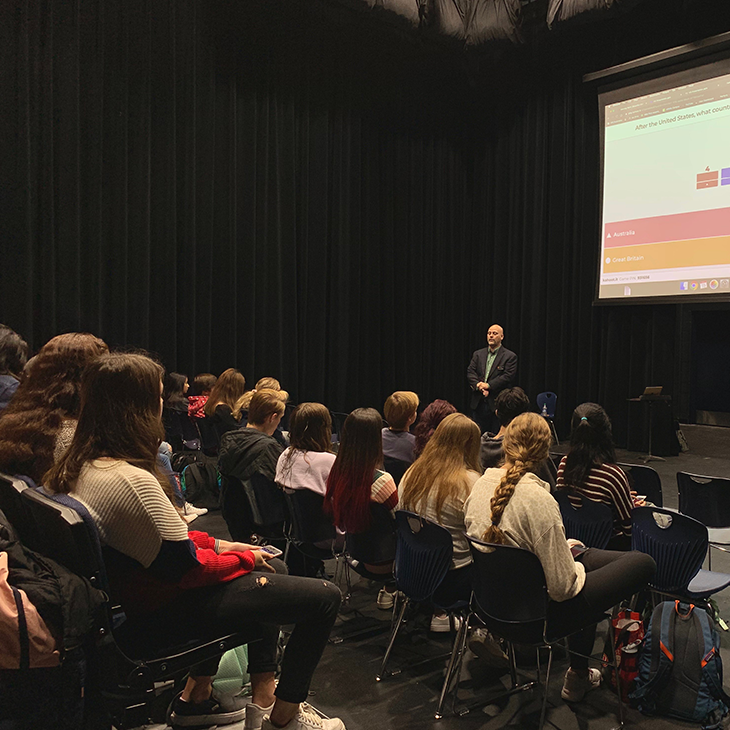
OSU professor partners with alumnus to promote foreign language education
Tuesday, March 10, 2020
Speaking teachers’ language
While research shows foreign language classes prepare students for college and the workforce, nearly one-third of Oklahoma public high schools do not offer any foreign language for students, according to Oklahoma Watch. Many schools closing programs are unable to find teachers.
Dr. Joe Terantino, assistant professor in the School of Teaching, Learning and Educational Sciences, teaches foreign language education courses at Oklahoma State University. With few students in his courses, he said he takes a more proactive approach to meeting the teacher shortage – recruiting students himself. Terantino travels to high schools across Oklahoma discussing with students the value of foreign language education.
“As the number of teachers available has decreased and as budget scenarios have developed, administrations sometimes see language programs as one of the first expendable pieces,” Terantino said. “Many of these are in small towns and rural areas where they lose a teacher and cannot replace them, so they decide that is where they are going to save a penny.”
Ezequiel Madrigal, a foreign language teacher at Edmond North High School and 2017 graduate of the OSU foreign language education program, added the few foreign language teachers still in the classroom often shoulder more responsibility.
“I know of high school teachers who have to give up their planning period to teach extra sessions,” Madrigal said. “And they are doing it on top of larger class sizes, thirty up to forty students sometimes.”
Both Terantino and Madrigal know the foreign language teacher shortage will require a multi-pronged approach. Terantino believes encouraging native speakers to become foreign language teachers, working with foundations to offer scholarships for future foreign language teachers and inspiring high school students to pursue upper-level foreign language courses are all part of the solution. And as a classroom teacher, Madrigal sees firsthand the importance of community support.
“I would love to see communities support local schools’ foreign language education,” Madrigal said. “When parents know the value, they’re ultimately going to encourage their students to take it, and when the kids know it’s valuable, they’re ultimately going to learn better.”
Working with Terantino, who conducts outreach visits to high schools with high percentages of graduates who attend OSU, was a perfect fit. Terantino discusses the role of foreign language in building acceptance of cultural diversity and workforce preparation, then uses follow-up surveys to gauge students’ perspectives on language learning and teaching as a career.
“My research aims to determine if we can influence or change students’ perceptions concerning the value of learning a second language and that of teaching as a career through direct intervention,” Terantino said.
Terantino said he highlights the benefits of studying foreign language during his presentations with high school students. Increased workforce pay and better understanding of cultural diversity are two of many reasons he encourages students to continue studying foreign language in high school. If more students study foreign language in high school, he believes there will one day be more foreign language education teachers.
Student feedback from the events has been positive, with responses in post-presentation surveys ranging from, “I want to be fluent in Spanish by the time I finish college,” to a recognition of the importance of cultural diversity with, “Languages can affect how other people view you as a person, and you are able to affect and help the people around you.”
As Terantino seeks to personally connect with high school students studying foreign languages for his research, he also wants them to know they will have a similar experience if they study foreign language education at OSU. Students can pursue an undergraduate degree in secondary education with an option in foreign language or a graduate certificate designed for professionals not yet certified to teach.
“One of the strengths of the foreign language education program is it has small classes, so you get individual attention. I’m highly accessible,” Terantino said. “I know my students’ strengths and weaknesses, where they want to end up personally and professionally, and I can help develop their craft and point them in the direction of specific jobs and geographic locations where they would like to teach.”
MEDIA CONTACT: Brittany Bowman | 405-744-9347 | brittany.bowman@okstate.edu
